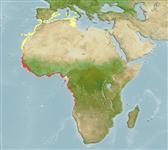Environment: milieu / climate zone / depth range / distribution range
Écologie
marin; saumâtre démersal; profondeur 10 - 100 m (Ref. 10001). Subtropical; 44°N - 13°S, 18°W - 14°E (Ref. 128784)
Eastern Atlantic: Gibraltar and extreme western Mediterranean southward along the entire west coast of Africa to Angola, near Benguela.
Taille / Poids / Âge
Maturity: Lm ? range ? - ? cm
Max length : 80.0 cm TL mâle / non sexé; (Ref. 7059); common length : 55.0 cm TL mâle / non sexé; (Ref. 2683); poids max. publié: 4.3 kg (Ref. 4699)
Common in shallow coastal waters, also in estuaries (Ref. 2683), bays and lagoons, as well as in offshore trawling stations. Feeds on crabs, echinoids and mollusks (Ref. 10001). Occurs over hard substrate (Ref. 5377).
Life cycle and mating behavior
Maturité | Reproduction | Frai | Œufs | Fécondité | Larves
Shipp, R.L., 1990. Tetraodontidae. p. 1069-1072. In J.C. Quero, J.C. Hureau, C. Karrer, A. Post and L. Saldanha (eds.) Check-list of the fishes of the eastern tropical Atlantic (CLOFETA). JNICT, Lisbon; SEI, Paris; and UNESCO, Paris. Vol. 2. (Ref. 7464)
Statut dans la liste rouge de l'IUCN (Ref. 130435: Version 2024-1)
Menace pour l'homme
Harmless
Utilisations par l'homme
Pêcheries: commercial; pêche sportive: oui
Outils
Articles particuliers
Télécharger en XML
Sources Internet
Estimates based on models
Preferred temperature (Ref.
123201): 19.2 - 27.9, mean 25.7 °C (based on 86 cells).
Phylogenetic diversity index (Ref.
82804): PD
50 = 1.0000 [Uniqueness, from 0.5 = low to 2.0 = high].
Bayesian length-weight: a=0.01622 (0.00726 - 0.03621), b=2.92 (2.74 - 3.10), in cm total length, based on LWR estimates for this (Sub)family-body shape (Ref.
93245).
Niveau trophique (Ref.
69278): 3.6 ±0.53 se; based on food items.
Résilience (Ref.
120179): Milieu, temps minimum de doublement de population : 1,4 à 4,4 années (Preliminary K or Fecundity.).
Fishing Vulnerability (Ref.
59153): Moderate to high vulnerability (52 of 100).
Nutrients (Ref.
124155): Calcium = 51.9 [17.6, 122.7] mg/100g; Iron = 0.96 [0.54, 1.98] mg/100g; Protein = 19.1 [17.0, 21.3] %; Omega3 = 0.374 [0.175, 0.735] g/100g; Selenium = 30.7 [16.8, 64.2] μg/100g; VitaminA = 8.44 [3.70, 19.02] μg/100g; Zinc = 0.725 [0.529, 1.009] mg/100g (wet weight);
